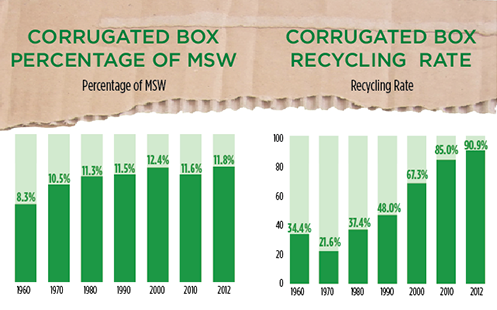Corrugated boxes are named for the fluted inner layer that is sandwiched between layers of linerboard. Corrugated boxes need to be impact, drop, and vibration-damage resistant, while still being light enough to ship products. Corrugated packaging is the largest segment of the packaging industry, with about 1500 manufacturing plants in the United States and Canada.
Paper recyclers call used corrugated boxes “old corrugated containers” or “OCC”. Consumers often mistakenly call them “cardboard boxes”. Those boxes, however, do not have a fluted inner layer and lack the strength of a corrugated box. The term “double-lined kraft” refers to cuttings generated from the manufacturing of corrugated containers.
The extensive use of corrugated boxes in the American economy makes them the biggest manufactured product in the waste stream by weight. Fortunately, OCC is easily recyclable, which also makes it the most recycled product by weight and greatly diminishes the amount sent to disposal. Since 1960, OCC generation increased by 302 percent; its MSW market share increased by 42 percent; its recycling rate increased by 164 percent and its disposal share decreased by 72 percent. Corrugated box production has benefitted from the rise in on-line shopping due to the need for more small shipping boxes for those shipments than the much larger boxes that would be used to ship products to brick and mortar stores.
While some corrugated boxes are made of plastic, this profile is limited to paper boxes.

OCC Municipal Solid Waste Facts (2012 EPA estimates)
Generated
29.48 million tons or 11.8 percent by weight.*
187.8 pounds per person per year.*
32.7 million tons (containerboard & unbleached kraft) according to industry data for 2013.
Recycled
26.8 million tons, for a 90.9% recycling rate.*
28.9 million tons or 88.5% in 2013 according to industry data.
Recycled Content
43 percent in 2006.
Corrugated medium usually has more recycled content than linerboard.
Composted
Compostable if shredded properly.
Incinerated or Landfilled
2.67 million tons or 1.6 percent of discarded MSW by weight.*
7047 Btus per pound compared to 4500-5000 for MSW.
Landfill Volume
26.3 million cubic yards or 6.2 percent of landfilled MSW in 1997.
Density
Landfilled OCC weighs 750 pounds per cubic yard (lbs/cu. yd).
Loose, unbaled OCC weighs 50-100 lbs/cu. yd.
Loose, unbaled, stacked OCC weighs 350 lbs/cu. yd.
Baled OCC weighs 1000-1200 lbs/cu. yd.
Source Reduction
10 to 15 percent weight reduction in last decade due to linerboard lightweighting.
Compression, stacking strength and burst tests limit the ability to lightweight corrugated boxes. Heavy use of recycled fibers can increase box weight to meet these tests.
Recycling Markets
Using OCC to make corrugated medium or linerboard is the largest market. Exports are next followed by using OCC to make recycled paperboard.
According to industry data, OCC accounted for almost half of the value of recovered paper exports in 2012.
End Market Specifications
ISRI Paper Stock Guidelines #11 (Old Corrugated Containers), #12 (Double sorted Old Corrugated) and #13 (New Double-Lined Kraft Corrugated Cuttings).
Contaminants include wax coatings, plastics, chipboard, mill wrappers, etc.
Sources:
American Forest and Paper Association
Municipal Solid Waste Generation, Recycling, and Disposal in the United States: Facts and Figures for 2012, USEPA, Office of Solid Waste, 2014
National Recycling Coalition, Washington DC, Measurement Standards and Reporting Guidelines
Scrap Specifications Circular 2014, Institute of Scrap Recycling Industries, Washington, DC
About the Author(s)
You May Also Like




